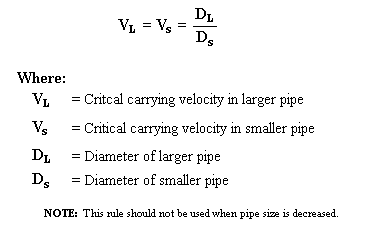Solids and Slurries - Definitions & Applications
APPARENT VISCOSITY - The viscosity of a non-Newtonian slurry at a particular rate of shear, expressed in terms applicable to Newtonian fluids.
CRITICAL CARRYING VELOCITY - The mean velocity of the specific slurry in a particular conduit, above which the solids phase remains in suspension, and below which solid-liquid separation occurs.
EFFECTIVE PARTICLE DIAMETER - The single or average particle size used to represent the behavior of a mixture of various sizes of particles in a slurry. This designation is used to calculate system requirements and pump performance.
FRICTION CHARACTERISTIC - A term used to describe the resistance to flow which is exhibited by solid-liquid mixtures at various rates of flow.
HETEROGENEOUS MIXTURE - A mixture of solids and a liquid in which the solids are not uniformly distributed.
HOMOGENEOUS FLOW (FULLY SUSPENDED SOLIDS) - A type of slurry flow in which the solids are thoroughly mixed in the flowing steam and a negligible amount of the solids are sliding along the conduit wall.
HOMOGENEOUS MIXTURE - A mixture of solids and a liquid in which the solids are uniformly distributed.
NON-HOMOGENEOUS FLOW (PARTIALLY SUSPENDED SOLIDS) - A type of slurry flow in which the solids are stratified, with a portion of the solids sliding along the conduit wall. Sometimes called the "heterogeneous flow," or "flow with partially suspended solids."
NON-SETTING SLURRY - A slurry in which the solids will not settle to the bottom of the containing vessel or conduit, but will remain in suspension, without agitation, for long periods of time.
PERCENT SOLIDS BY VOLUME - The actual volume of the solid material in a given volume of slurry, divided by the given volume of slurry, multiplied by 100.
PERCENT SOLIDS BY WEIGHT - The weight of dry solids in a given volume of slurry, divided by the total weight of that volume of slurry, multiplied by 100.
SALTATION - A condition which exists in a moving stream of slurry when solids settle in the bottom of the stream in random agglomerations which build up and wash away with irregular frequency.
SETTLING SLURRY - A slurry in which the solids will move to the bottom of the containing vessel or conduit at a discernible rate, but which will remain in suspension if the slurry is agitated constantly.
SETTLING VELOCITY - The rate at which the solids in a slurry will move the bottom of a container of liquid that is not in motion. (Not to be confused with the velocity of a slurry that is less than the critical carrying velocity as defined above.)
SQUARE ROOT LAW - A rule used to calculate the approximate increase in critical carrying velocity for a given slurry when pipe size is increased. It states:

VISCOSITY TYPE - (For definitions of the various types of viscosities applicable to slurries, see Rheological Definitions.)
YIELD VALUE (STRESS) - The stress at which many non-Newtonian slurries will start to deform and below which there will be no relative motion between adjacent particles in the slurry.